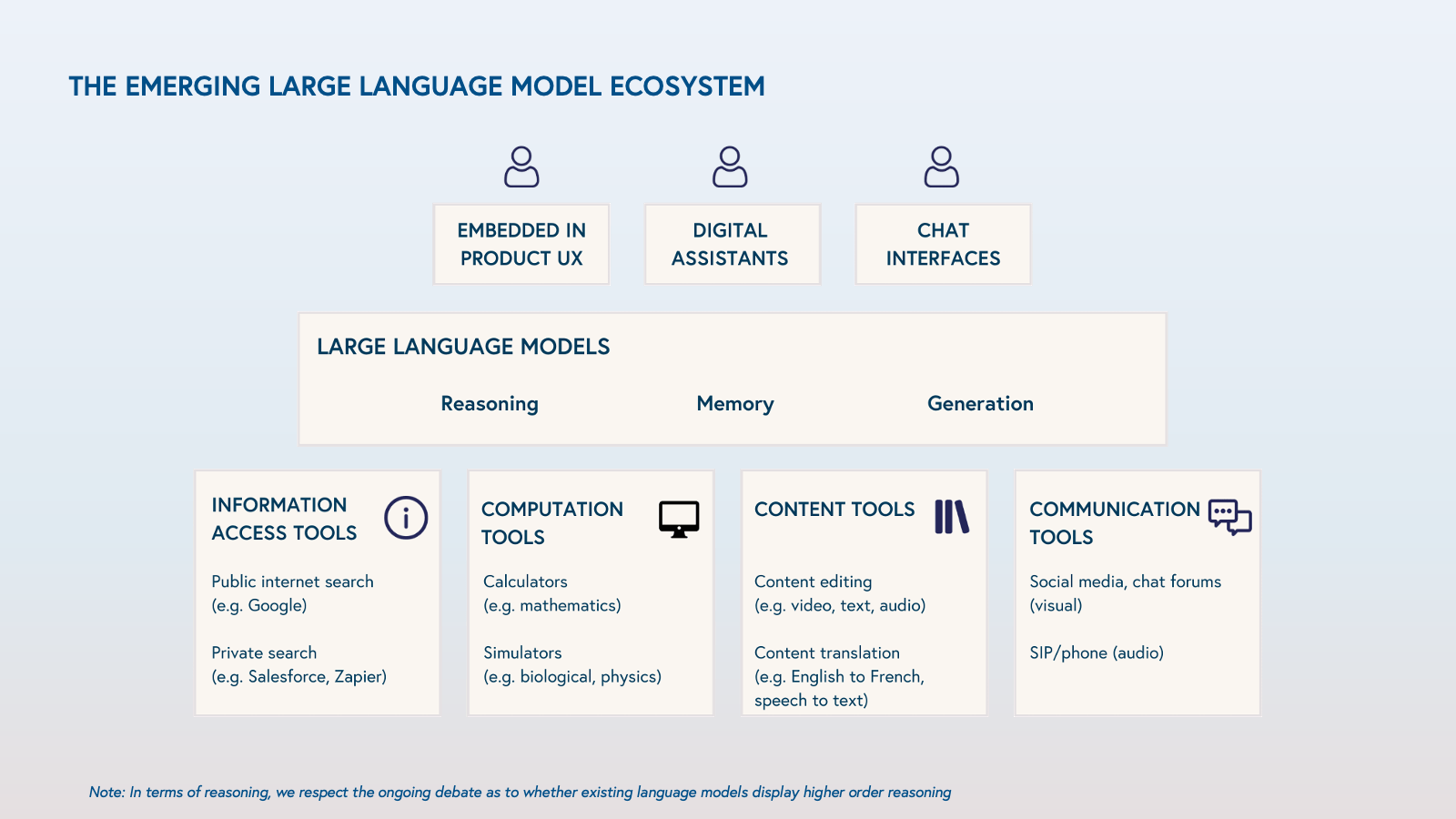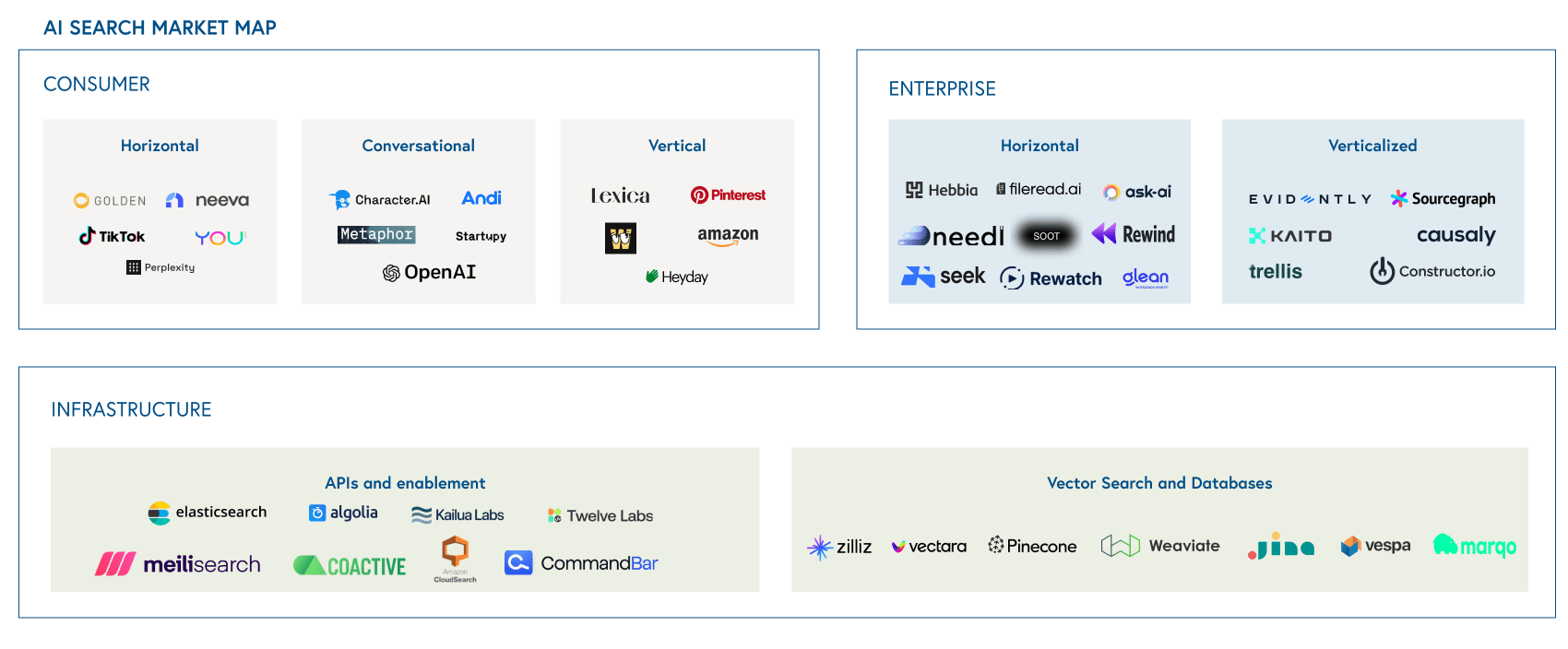Entering the era of Intelligent Search
Five AI breakthroughs that are shaping new paradigms for information synthesis and retrieval.
Generative AI is in the limelight as technologists take stock of the machine learning models released in the last year, including ChatGPT, Stable Diffusion, Dreamfusion, and soon to be GPT-4, among others. The trajectory and power of these large models is inspiring a new wave of startups. Bessemer had early conviction in the potential for large models to usher in a new era in technology. Today, we have conviction that AI models will also usher in a new era for search.
By search we don’t just mean public internet search like Google. We think of search as the ability to query information and ultimately synthesize and draw conclusions from it. This definition encompasses everything from enterprise document search to conversational consumer products.
Search is a trillion dollar opportunity that spans consumer, enterprise, and developer ecosystems—and with our AI-powered search market landscape, we explore what’s catalyzing these advancements.
Reimagining Search
Advances in machine learning and software infrastructure unlock new data types and empower search agents with contextual intelligence. This is possible thanks to:
1. Multimodal data & models. Historically, it has been difficult to search unstructured data like images and video. As evidenced by text-image models like OpenAI CLIP and LAION, recent breakthroughs have improved the fidelity of models that embed unstructured data into compact representations. These representations, frequently vectors, enable better multi-modal models across images, videos and other rich data types. Coactive.ai, for example, offers a SQL-like query interface for image data and helps teams quickly access, organize, and make use of their visual data.
2. Contextual awareness and basic reasoning. Search systems of the past offered lexical or keyword search, but modern models offer semantic search, or the ability to search with meaning. Modern search systems can also be context-aware, taking intent and history into account. And now, thanks to large language models, these systems can perform basic reasoning tasks. The result is a more intuitive and conversational search, one that can remember past searches and synthesize across sources. OpenAI’s ChatGPT is a recent example that offers markedly better search. ChatGPT surfaces information in a stateful call-and-response format, allowing users to iteratively refine and adjust their search experience. If a consumer asks, “What should I wear today?” the tool may respond with a probing question, such as “How do you want to be perceived?” before synthesizing an answer.
3. Building upon existing work. Many large language models plug into existing software stacks by integrating with APIs and dynamically interacting with user interfaces (e.g. next-gen search from Perplexity, Adept, OpenAI’s Codex, and Mind’s Eye at Google). Likewise, companies like Seek.ai and Hearth.ai wrap models around databases and CRMs. As language models interface more with existing products, search systems cover more ground and are better informed.

4. Infrastructure at scale. Companies discovering the value of vector embeddings, building and scaling their workloads atop vector databases like Zilliz (Milvus), Pinecone, Vespa, and Weaviate, and open-source libraries like Jina, Qdrant, and FAISS. Likewise, researchers are learning how factors like model size and data volumes affect model performance for large neural networks. The field of distributed deep learning has emerged, yielding optimization and parallelism techniques to further scale models and data volumes.
5. Search and recommendation. As search systems become more personalized, we predict the lines between search and recommendation will blur. TikTok, for example, has grown rapidly in recent years. The company’s personalized, ever-improving recommendation experience has managed to steal market share from traditional video search products like Youtube. We expect recommendation systems to proliferate in the coming years and take share from traditional search.
AI is reimagining search. We see enduring innovation across consumer and enterprise search, as well as the infrastructure layer.
AI search market map

Search is the tip of the iceberg
As AI makes it easier and cheaper to create high quality content, the volume of digital content is set to explode. We predicted that within the next ten years, at least 50% of online content will be generated by or augmented by AI. And with this explosion of information, we welcome better, intelligent search agents to organize and synthesize it.
The possibilities are vast—with user data now a first-class asset, enterprises can leverage search experiences to better analyze data for business decisioning. And in consumer-settings, people will benefit from more accurate, personalized, and curated results impacting how they might connect, shop, or learn. Powering these experiences is an emerging developer ecosystem to serve search queries and recommendations at scale.
While the landscape is evolving rapidly, we know one thing remains constant—curiosity and a thirst for answers. If you are working on AI native search products, we would love to hear from you! Please reach out to our team on Twitter: @bhavikvnagda, @TaliaGold, @SakibDadi, @KwalkyTalky, @AlexandraSukin.
Special thanks to Michele Catasta.







